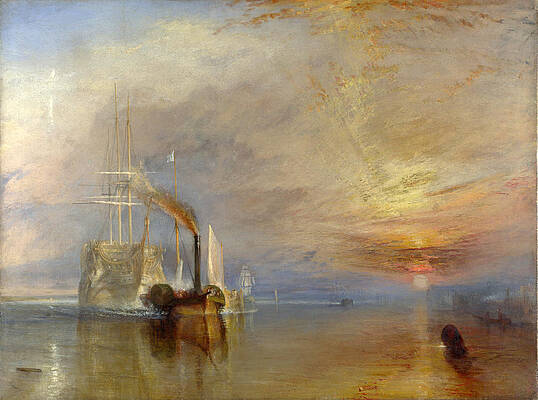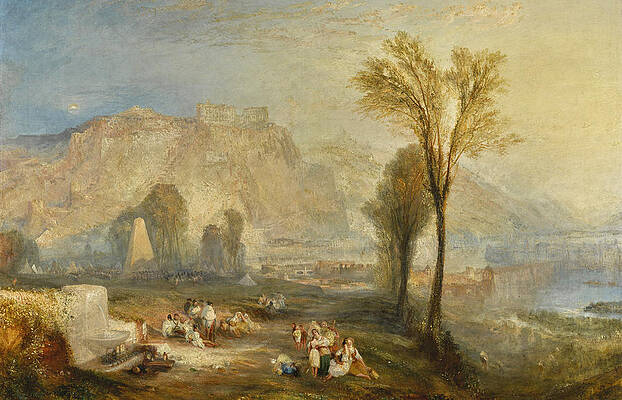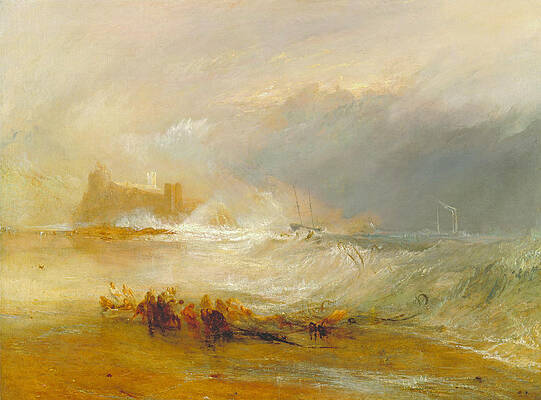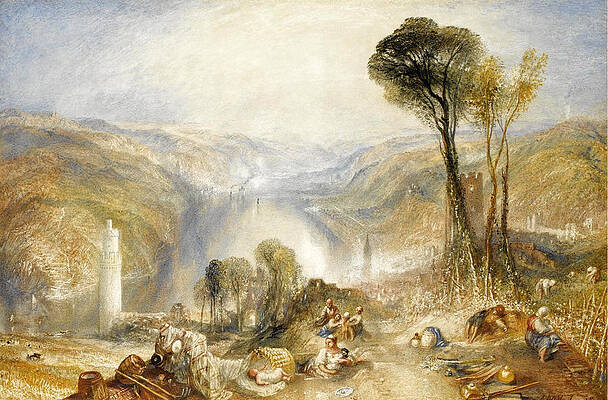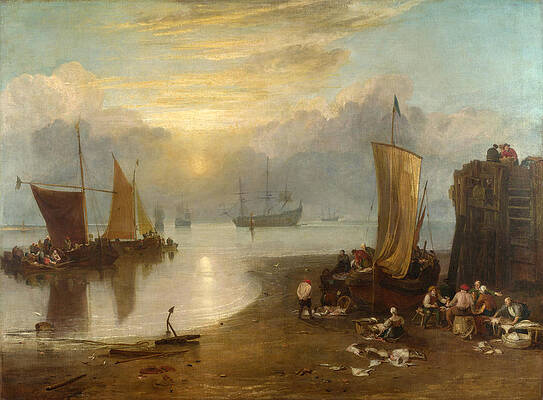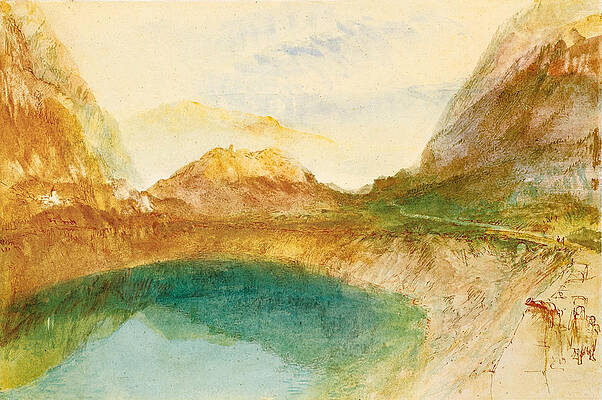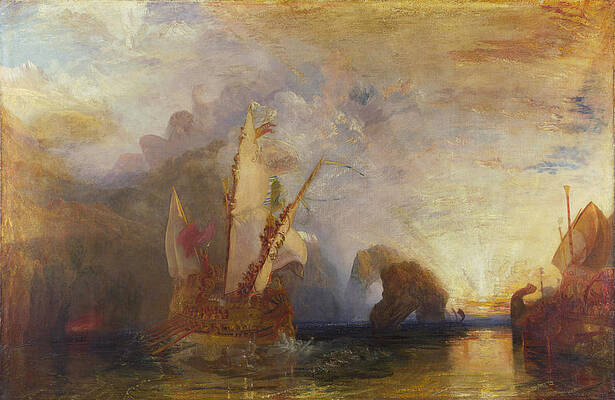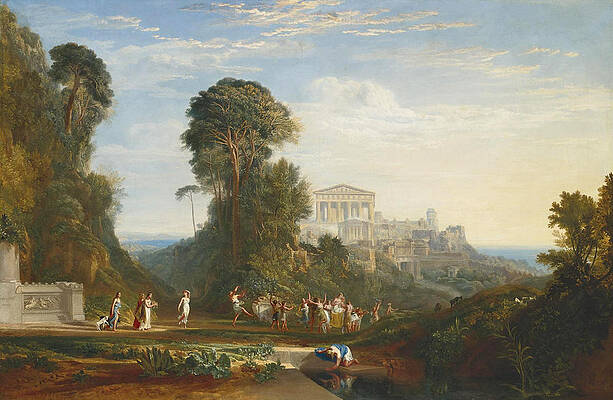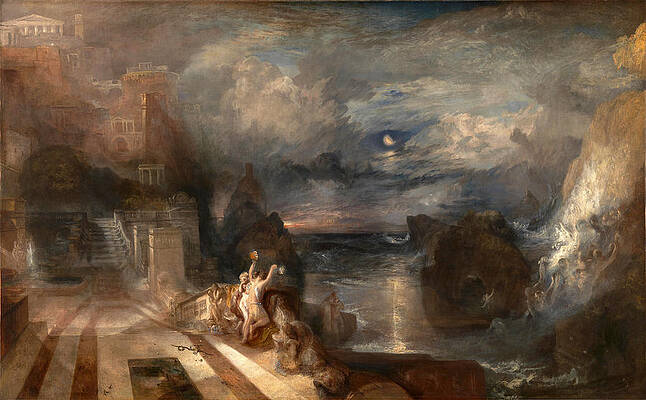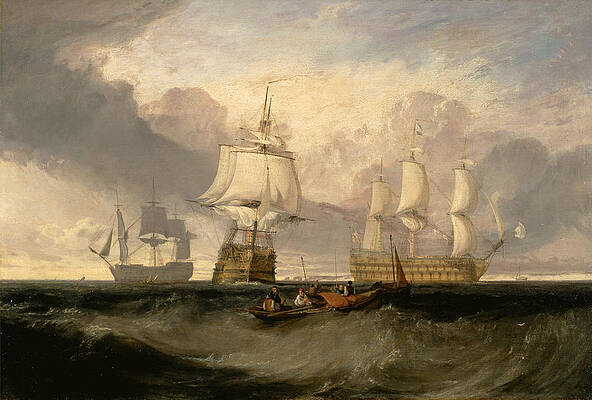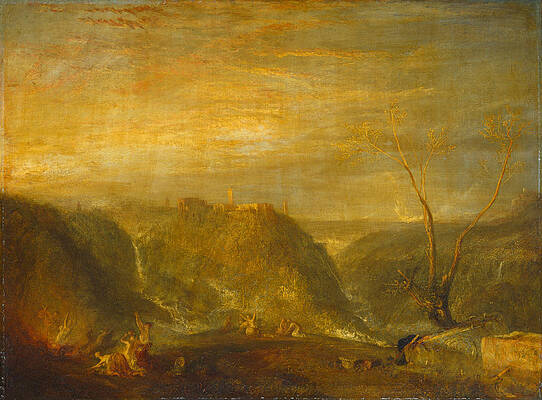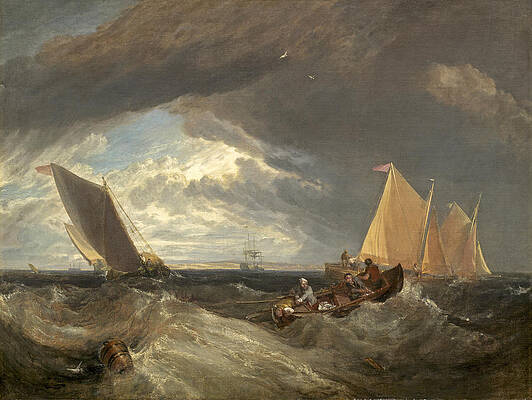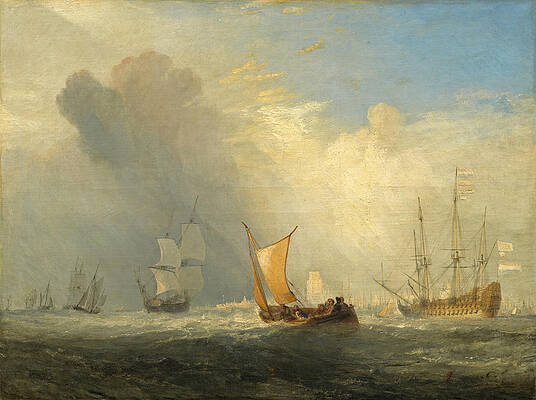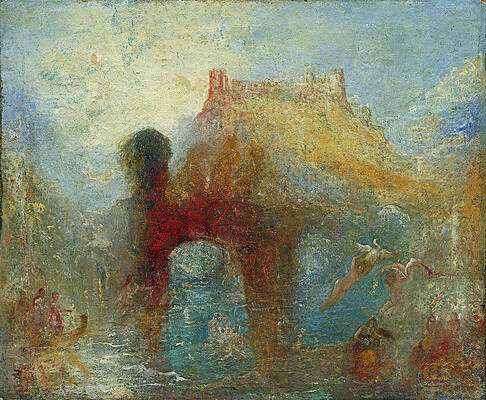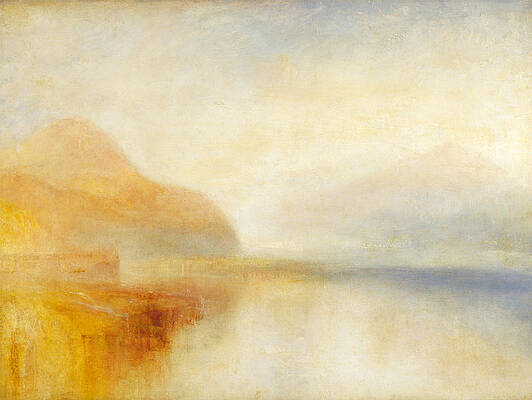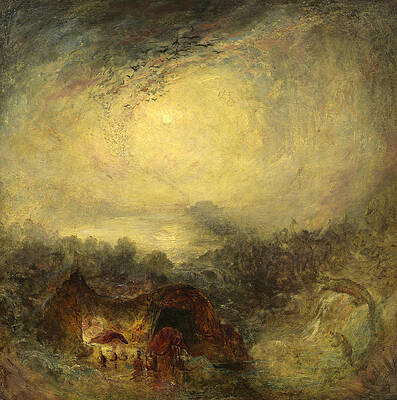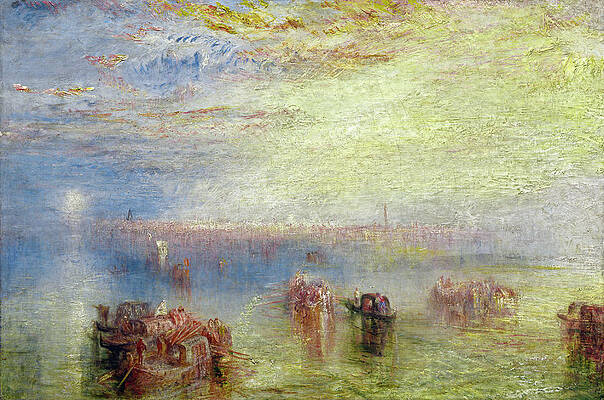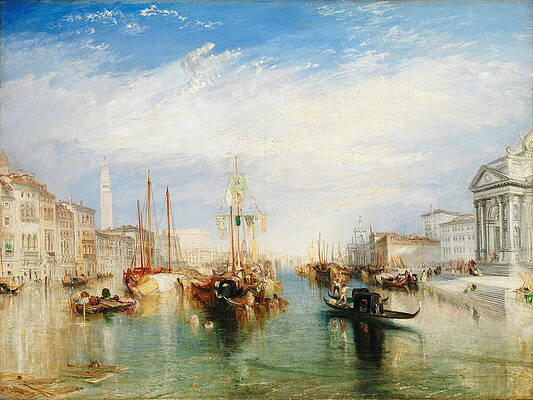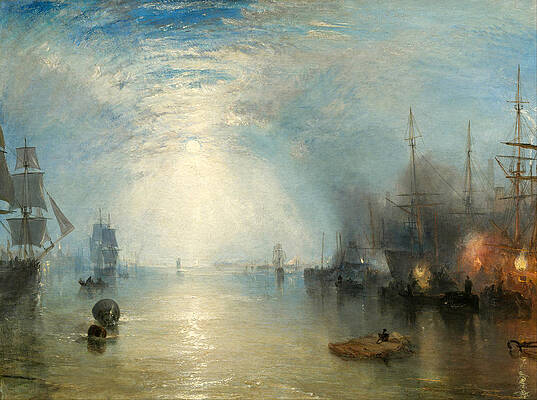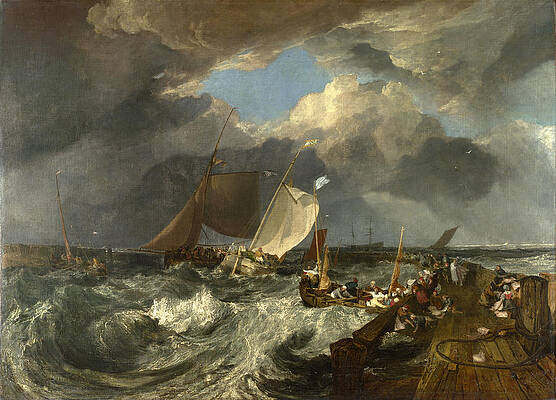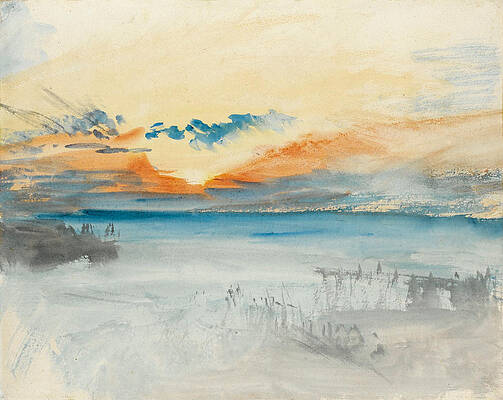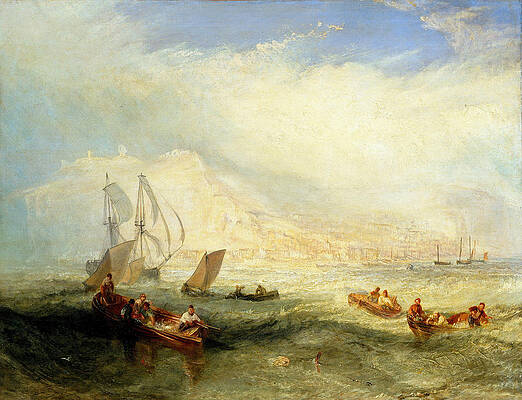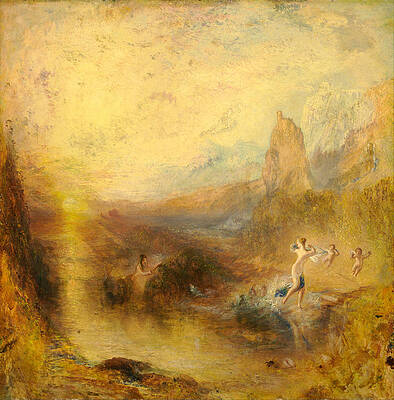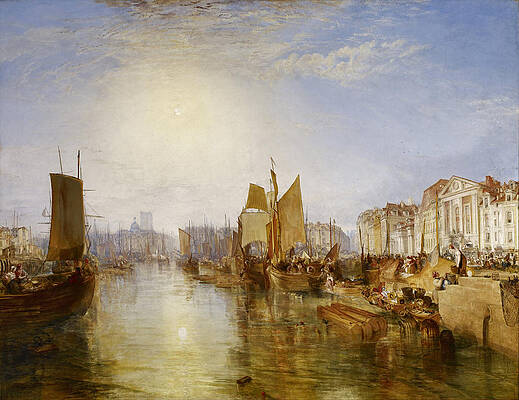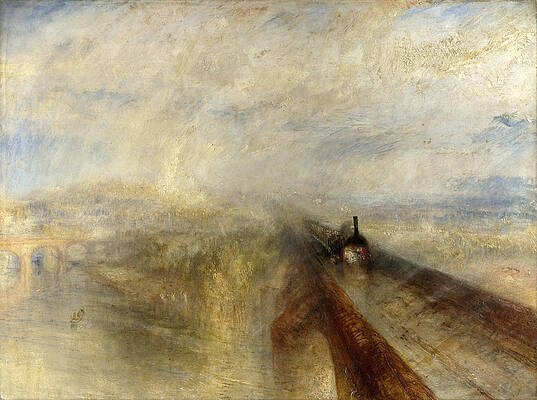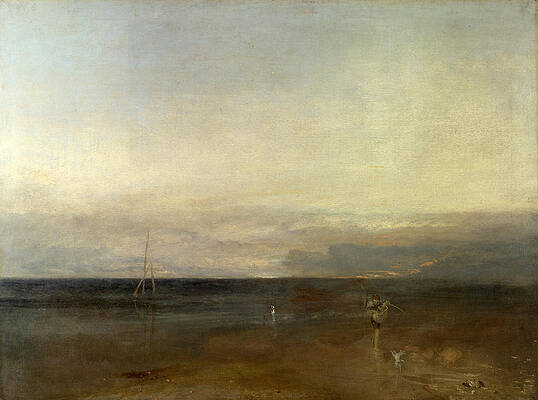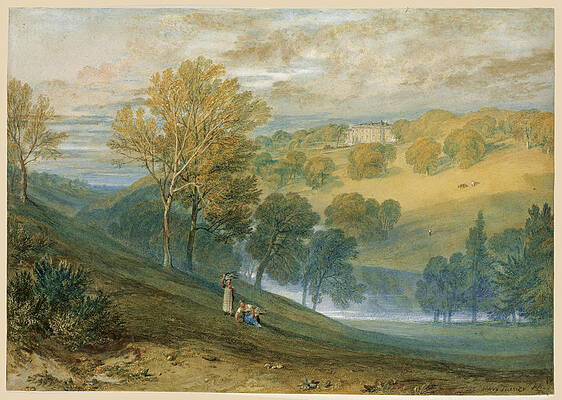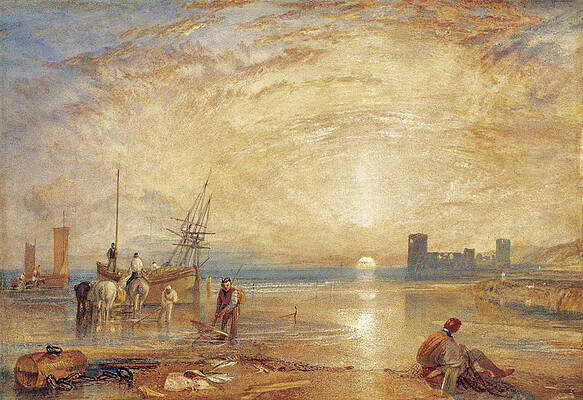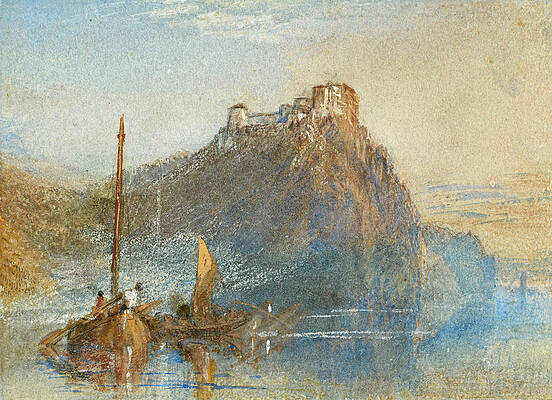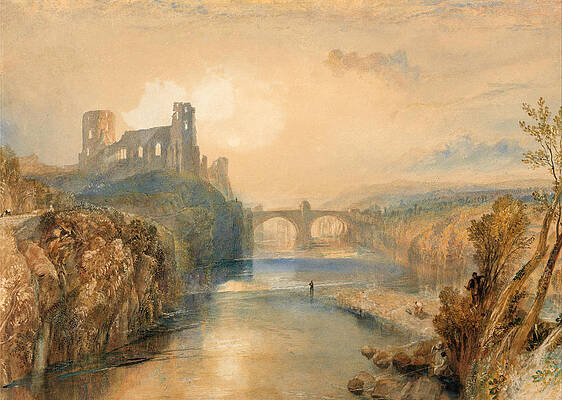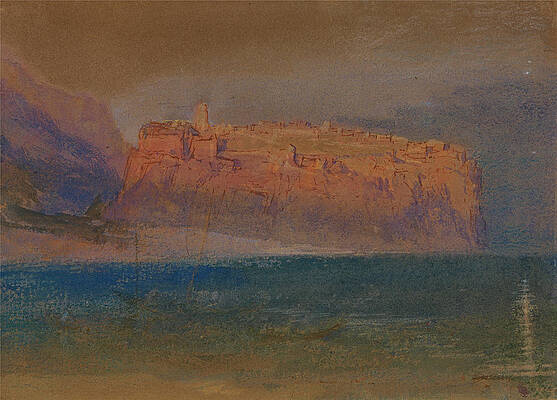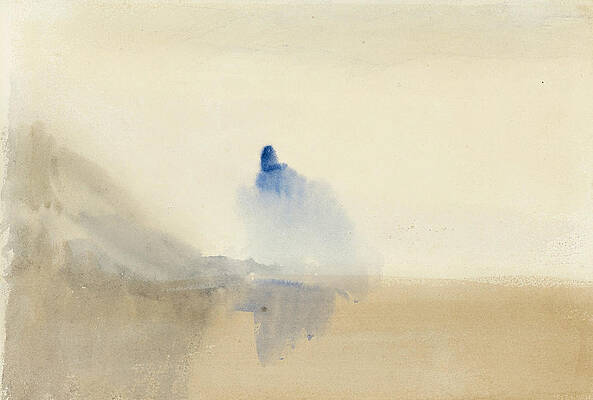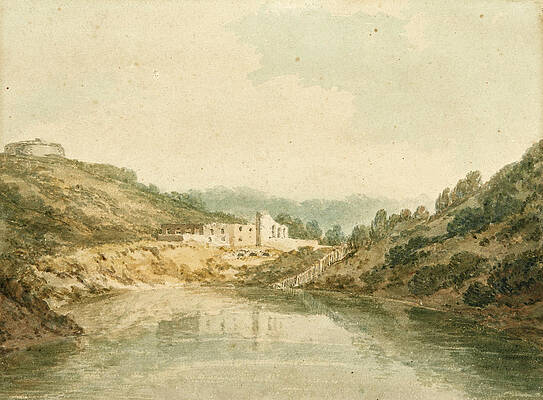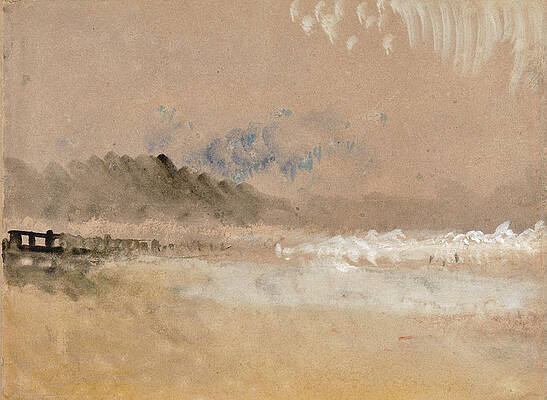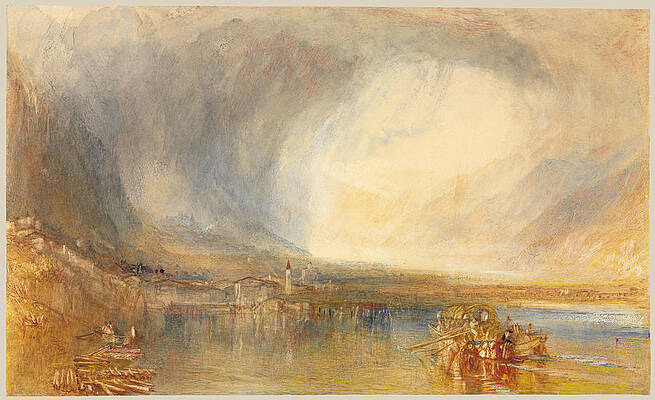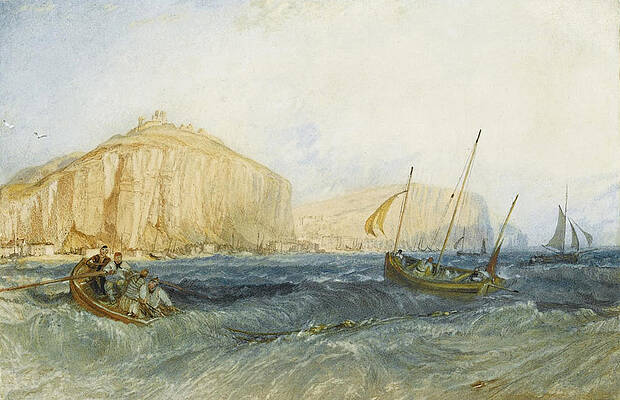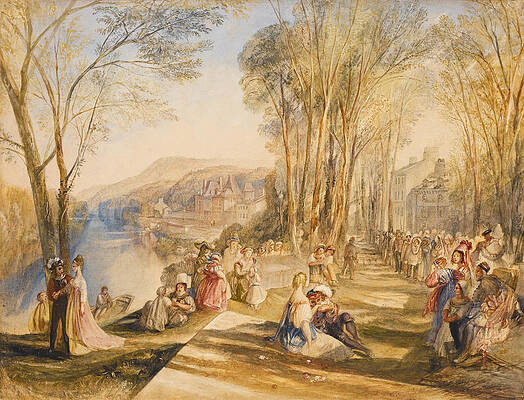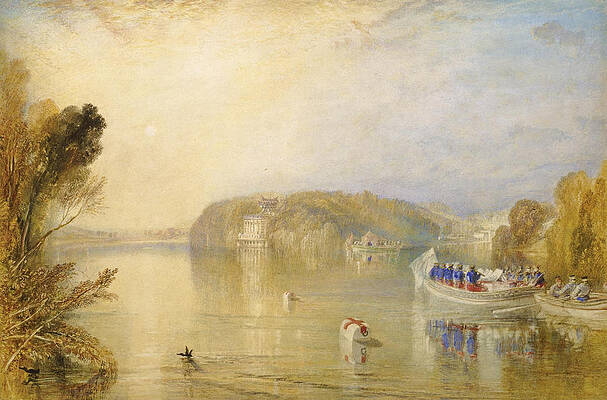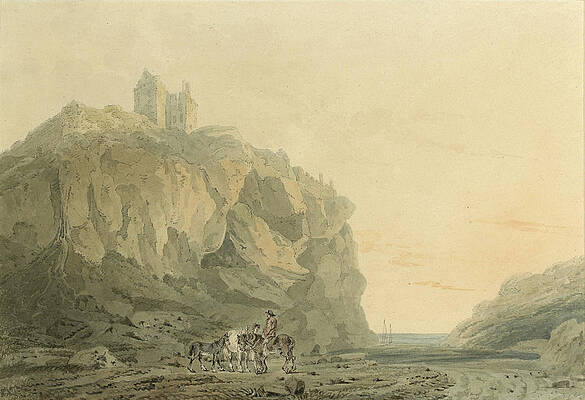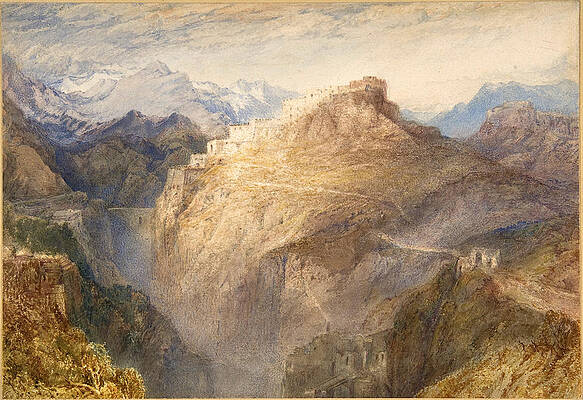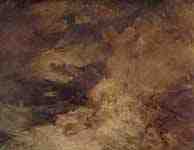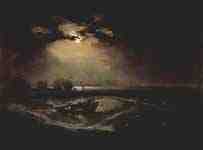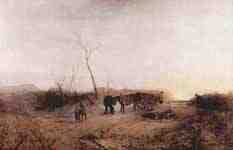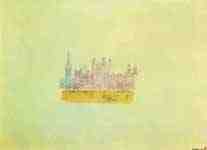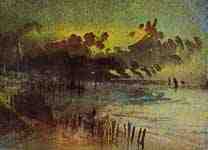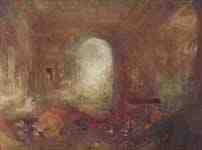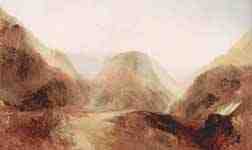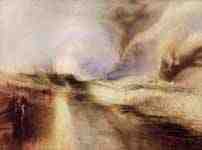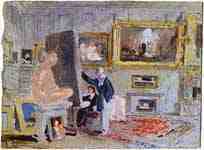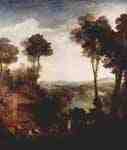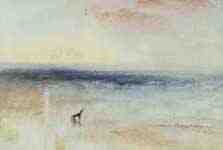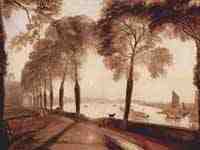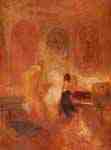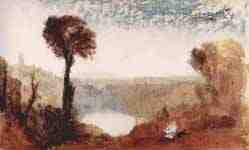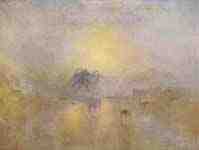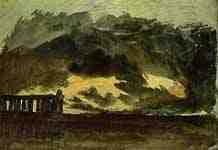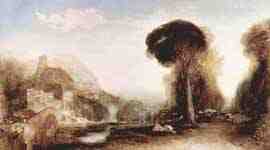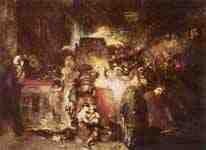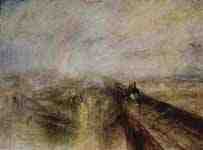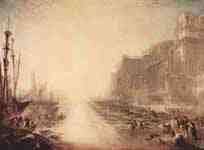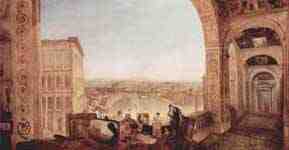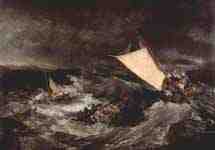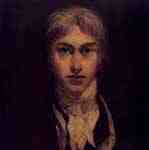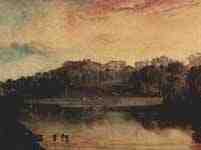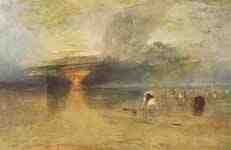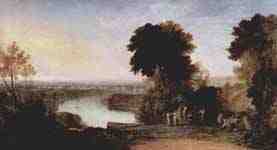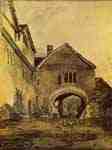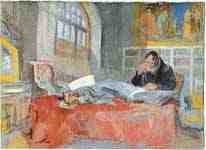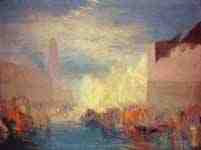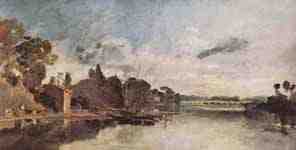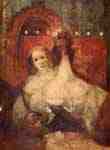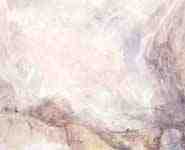Joseph Mallord William Turner
Paintings , Drawings
Whalers
The Fighting Temeraire
Ehrenbreitstein, or The Bright Stone
Wreckers. Coast of Northumberland, with a Steam-Boat Assisting a Ship off Shore
Oberwesel
Sun Rising through Vapour
A Shipwreck off Hastings
A Swiss Lake Lungernzee
Ulysses deriding Polyphemus. Homers Odyssey
The Temple of Jupiter Panellenius Restored
The Parting of Hero and Leander
Rhodes
Heidelberg with a Rainbow
Venice from Fusina
The Victory Returning from Trafalgar, in Three Positions
Mortlake Terrace
The Rape of Proserpine
The Junction of the Thames and the Medway
Rotterdam Ferry-Boat
Queen Mab's Cave
Inverary Pier, Loch Fyne, Morning
Rhodes
The Evening of the Deluge
Approach to Venice
Venice from the Porch of Madonna della Salute
Keelmen Heaving in Coals by Moonlight
Margate from the Sea
The Dogana and San Giorgio Maggiore
Calais Pier
Sunset over Water
Line Fishing. Off Hastings
Glaucus and Scylla
The Harbor of Dieppe
Rain Steam and Speed . The Great Western Railway
The Sun of Venice
The Evening Star
Gledhow Hall. Yorkshire
Flint Castle. North Wales
Chateau de Clermont on the River Loire. France
The Lake of Zug
View of London from Greenwich
Barnard Castle
Corsica
A Paddle-steamer in a Storm
Study of a Castle by a Lake
Porto Paone a bay in the island of Nisida near Naples
Caernarvon Castle North Wales
Surf on a beach. Margate
Fluelen, from the Lake of Lucerne
The Acropolis from the Pnyx, Athens, Greece
Fishing Boats off Hastings
The Field of Waterloo from the Picton Tree
Jerusalem
Palace of La Belle Gabrielle
Virginia Water
Eton from the Slough Road
Dunotter Castle, Kincardineshire
Chatel Argent and the Val d'Aosta from above Villeneuve
Fort of L'Essillon, Val de la Maurienne, France
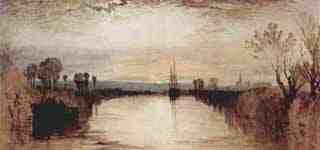
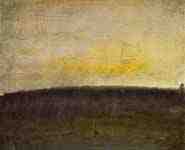
Beginnings with color: The pink sky
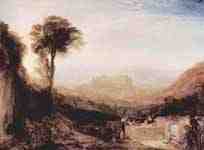

Lake Avernus : Aeneas and the Cumaean Sibyl
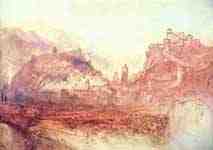

Bonneville Savoy with Mont Blanc
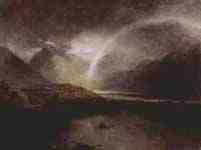
Buttermere Lake with partial view of Cromackwater
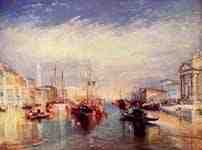
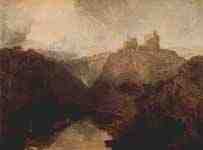
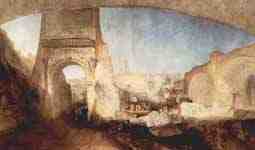
The Forum Romanum, for Mr Soane's Museum

The Burning of the Houses of Parliament
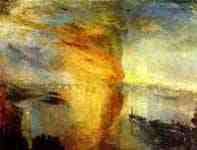
The burning of the parliament building , 16 October 1834
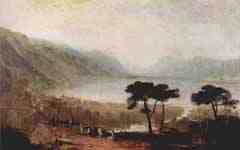
Lake Geneva view from Montreux
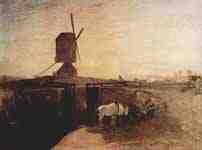
The large channel connection at Southall Mill
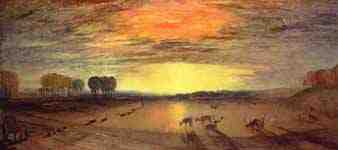
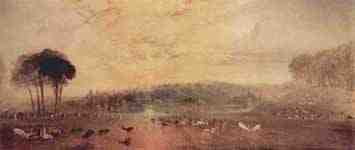

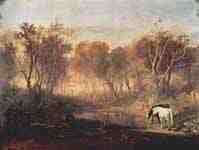
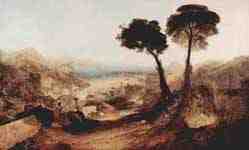
The Bay of Baiae, with Apollo and the Sybil

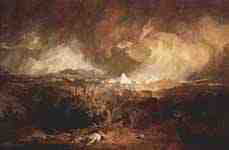
The fifth plague of Egypt ( The Plague)
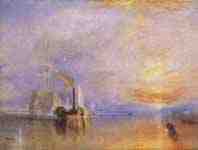
The last voyage of the " Fighting Temeraire "
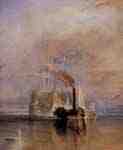
The last voyage of the " Fighting Temeraire " , detail
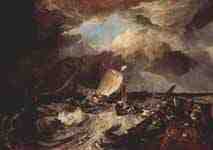

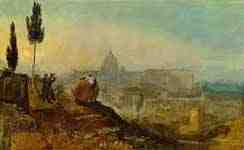
The Peter church from the south

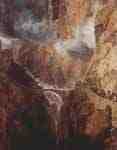
The Devil's Bridge, St. Gotthard
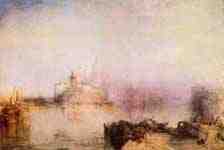
Dogana and Santa Maria della Salute, Venice
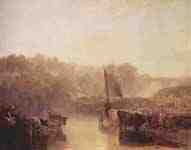

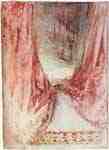

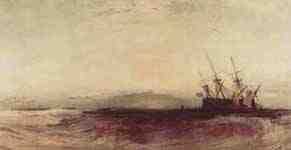
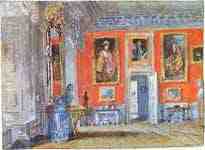
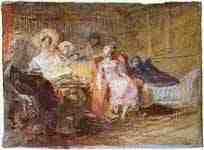
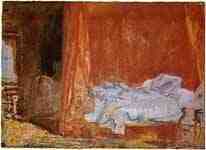
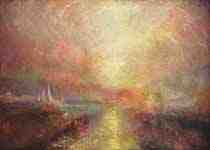
A sailing yacht approaches the Coast
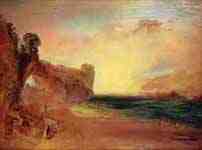 Rocky bay with classical figures
Rocky bay with classical figures
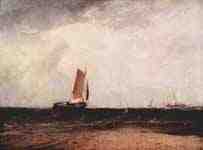 Fishing at Blythe - sand, the tide begins
Fishing at Blythe - sand, the tide begins
 House on the river with trees and sheep
House on the river with trees and sheep
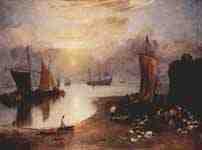 In the morning mist rising sun
In the morning mist rising sun
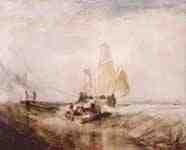 Now for the painter , passengers go on board
Now for the painter , passengers go on board
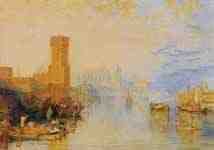 Cologne, View from the southeast
Cologne, View from the southeast
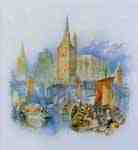 Cologne , Great St. Martin , Town Hall and Cathedral from the Rhine
Cologne , Great St. Martin , Town Hall and Cathedral from the Rhine
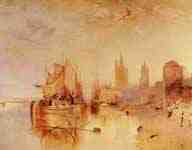 Cologne , Southern portion of the banks of the Rhine with the arrival of a mail ship
Cologne , Southern portion of the banks of the Rhine with the arrival of a mail ship
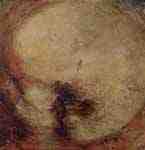 Light and Color : The Morning after the Deluge
Light and Color : The Morning after the Deluge
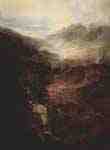 Morning in the Corniston Fells , Cumberland
Morning in the Corniston Fells , Cumberland
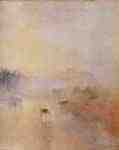 Norham Castle at Sunrise , detail
Norham Castle at Sunrise , detail
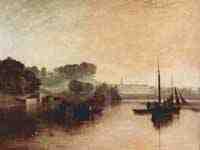 Pethworth Sussex, dewy morning
Pethworth Sussex, dewy morning
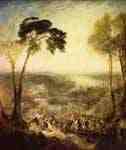 Phryne visits as Venus the public baths
Phryne visits as Venus the public baths
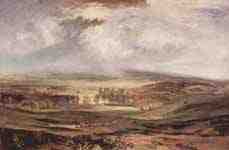 Raby Castle, the residence of the Earl of Darlington
Raby Castle, the residence of the Earl of Darlington
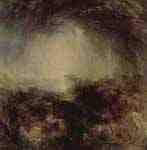 Shade and Darkness : The evening before the flood
Shade and Darkness : The evening before the flood
 Ship traffic in front of the headland of East Cowes
Ship traffic in front of the headland of East Cowes
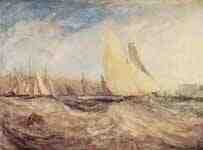 The flotilla sailing to windward
The flotilla sailing to windward
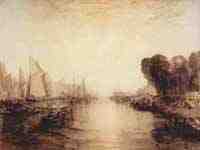 The Regatta Starting for their Moorings
The Regatta Starting for their Moorings
 Castle Saint- Michel, Bonneville , Savoy
Castle Saint- Michel, Bonneville , Savoy
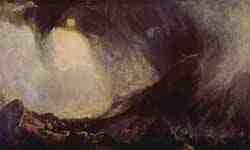 Hannibal and his army cross the Alps
Hannibal and his army cross the Alps
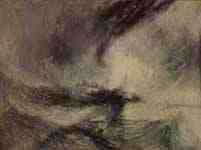 Snow storm off the harbor entrance
Snow storm off the harbor entrance
 Venice , San Benedetto , view of Fusina
Venice , San Benedetto , view of Fusina
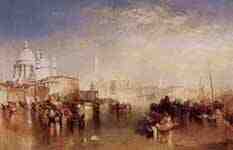 Venice , seen from the Giudecca Canal
Venice , seen from the Giudecca Canal
 Ships Bearing up for Anchorage
Ships Bearing up for Anchorage
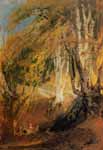
A Beech Wood with Gipsies Round a Camp Fire

A Beech Wood with Gipsies Seated in the Middle Distance
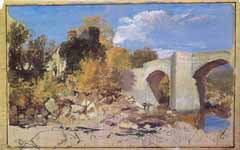
A Bridge with a Cottage and Trees beyond
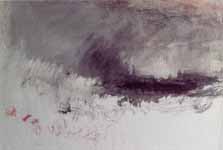
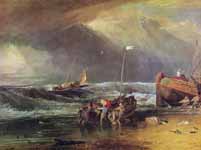
A Coast Scene with Fishermen Hauling a Boat Ashore
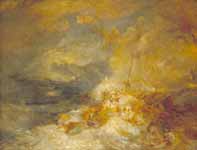
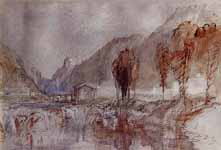
A Distant Castle with Poplar Trees beside a River
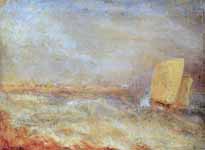
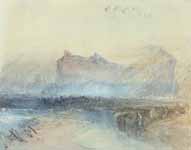
A View in the Domleschg Valley, Switzerland
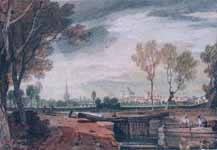
Abingdon from the Thames Navigation
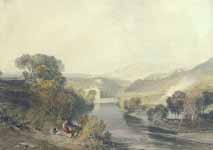
Addingham Mill on the River Wharfe, Yorkshire
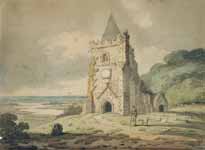
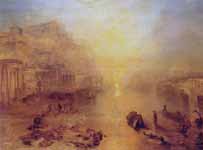
Ancient Italy - Ovid banished from Rome
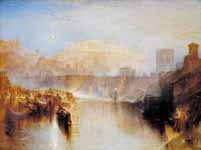
Ancient Rome - Agrippina Landing with the Ashes of Germanicus
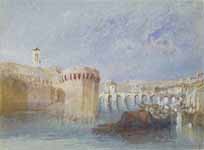
Angers - The Walls of Doutre with the Tower of the Church of La Trinite
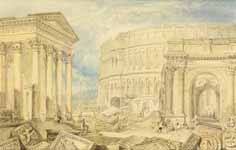
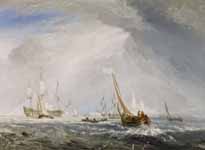
Antwerp - Van Goyen Looking Out for a Subject
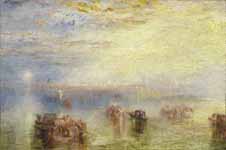
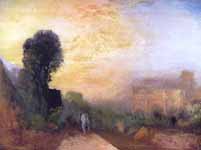

Arno, A Villa Among Trees and Bushes

Autumn Morning near Foothill, Wiltshire
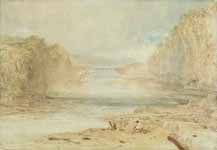
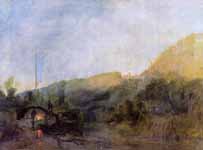
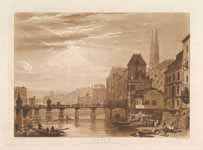
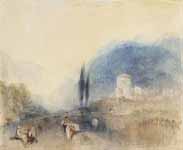

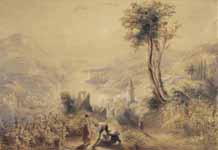
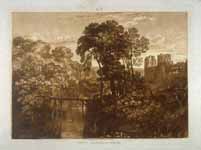
Berry Pomeroy Castle (Raglan Castle)

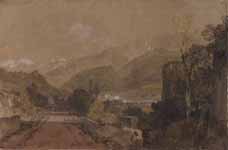
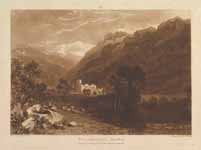

Bonneville, Savoy, with Mont Blanc
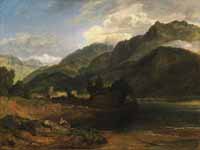
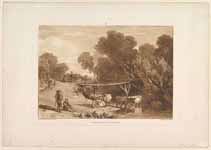
Bridge and Cows, from Liber Studiorum, part I
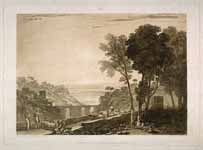
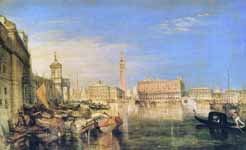
Bridge of Sighs, Ducal Palace and Custom-House, Venice
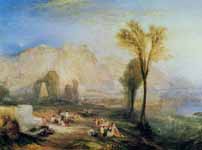
Bright Stone of Honour and Tomb of Marceau, from Byron's Childe Harold
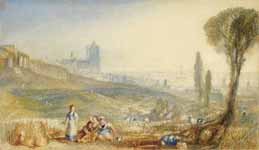
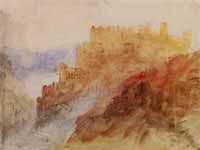
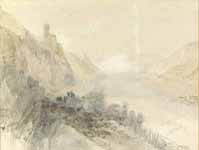
Burg Sooneck on the Rhine, Germany
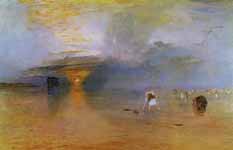
Calais Sands, Low Water, Poissards Collecting Bait
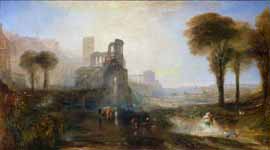

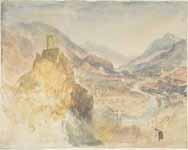
Chatel Argent and the Val d'Aosta from above Villeneuve
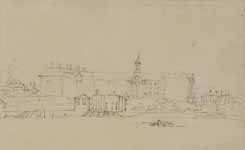
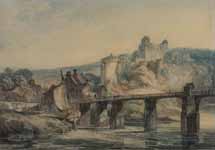

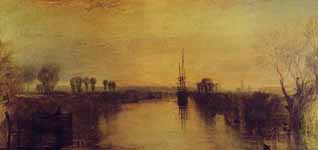
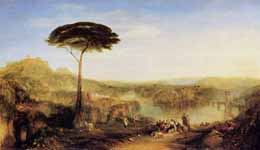
Childe Harold's Pilgrimage - Italy

Christ Driving the Traders from the Temple
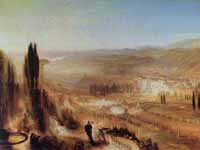
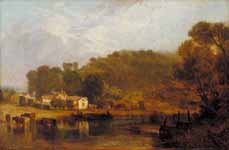
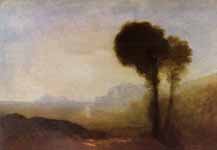
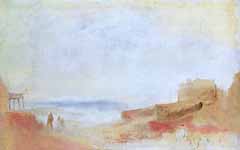
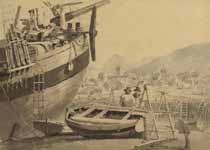
Coast Scene, with Boat in the Foreground - near Dover
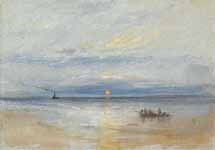
Coastal View at Sunset with Fishing Boat Returning to Port
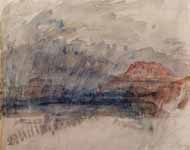
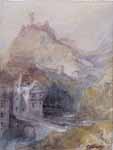
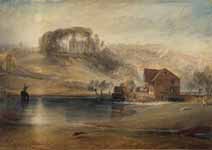

Cologne - The Arrival of a Packet-Boat, Evening
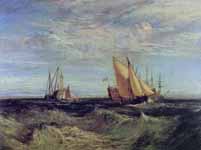
Confluence of the Thames and the Medway
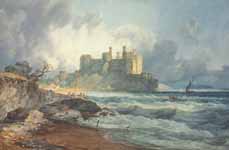

Crook of Lune, Looking towards Hornby Castle
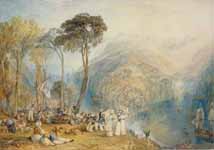

Dawn of Christianity (Flight into Egypt)
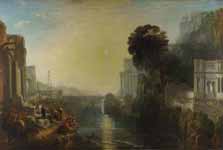
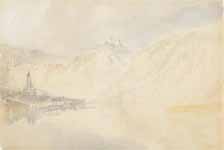
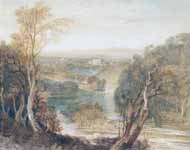
Distant View of Barden Tower on the Rver Wharfe, West Riding, Yorkshire
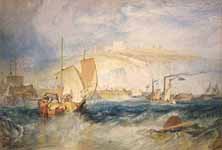
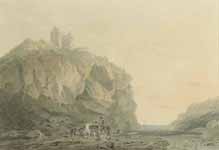
Dunotter Castle, Kincardineshire
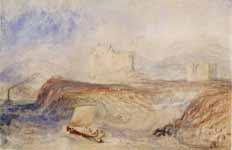
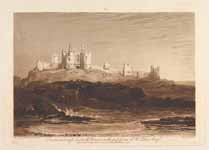
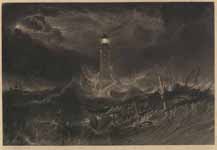
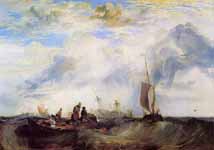

Eu, The Church of Notre-Dame and Saint-Laurent

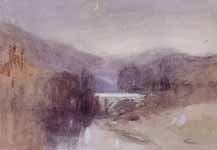
Evening Landscape with a Tower and Bridge

Evening Landscape, probably Chichester Canal

Fall of the Rhine at Schaffhausen
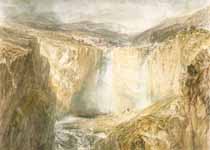
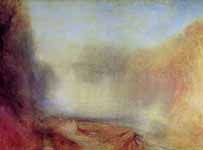
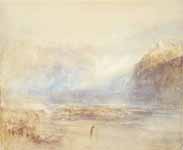
Falls of the Rhine at Schaffhausen - Distant View
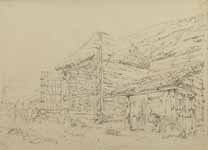

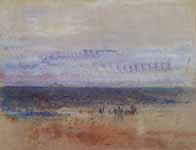
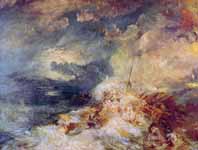


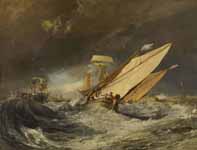
Fishing Boats Entering Calais Harbor.
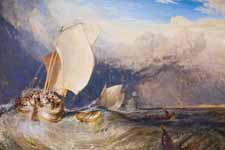
Fishing Boats with Hucksters Bargaining for Fish

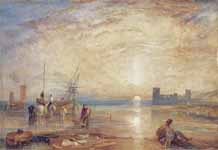
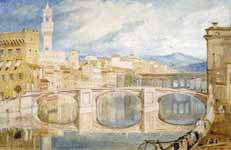
Florence from the Ponte alla Carraia
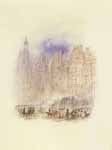
Fontainebleau -The Departure of Napoleon
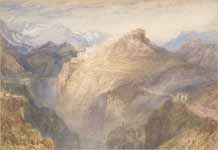
Fort of L`Essillon, Val de la Maurienne, France

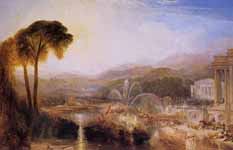

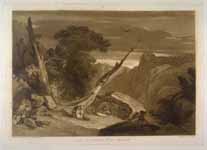
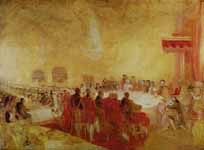
George IV at the Provost's Banquet in the Parliament House, Edinburgh
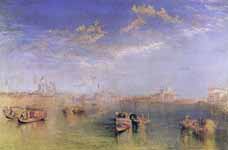
Giudecca, la Donna della Salute and San Georgio
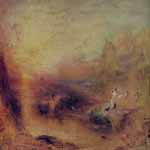
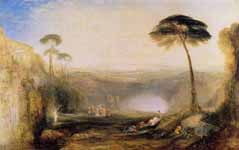
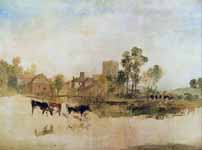

Haddon Hall near Bakewell, Derbyshire

Harbour of Dieppe (Changement de Domicile)

Harbour with Town and Fortress
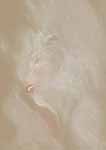
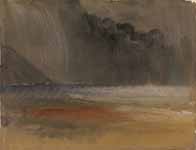
Heaped Thundercloud over Sea and Land
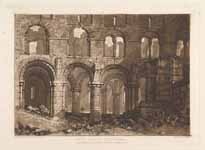

Interior of Salisbury Cathedral
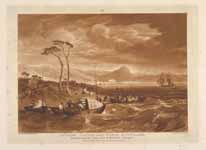
Inverary Castle and Town, Scotland
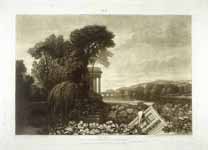
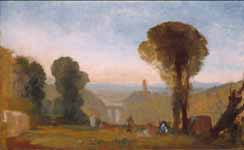
Italian Landscape with Bridge and Tower
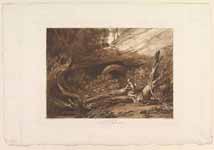
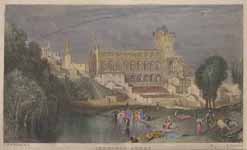
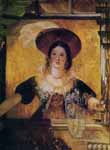
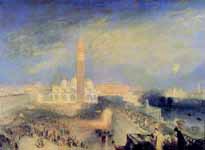
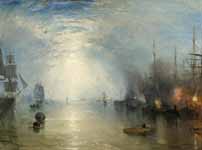
Keelmen Heaving in Coals by Moonlight
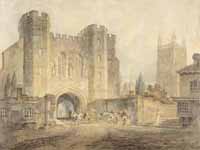

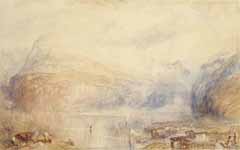
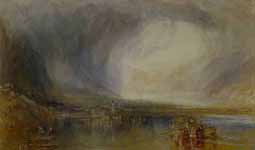
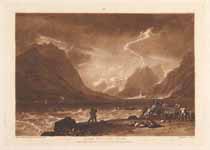
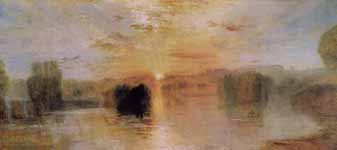
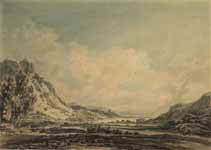

Landscape with a River and a Bay in the Background

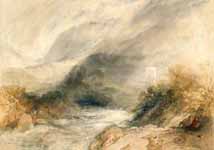

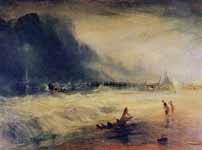
Life-Boat and Manby Apparatus going off to a Stranded Vessel making Signal of Distress
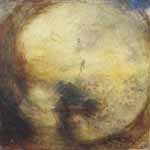
Light and Color - Moses Writing the Book of Genesis

Little Devil's Bridge over the Russ, above Altdorft, Swiss

Llangollen, Denbighshire, Wales
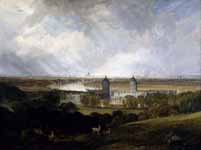
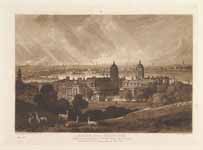

Low Sun and Clowds over a Calm Sea
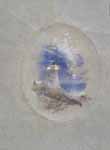


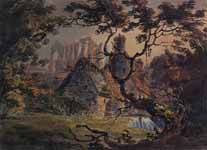
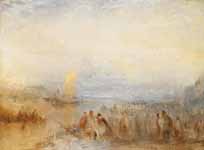
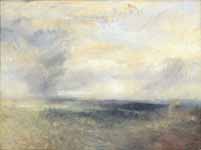
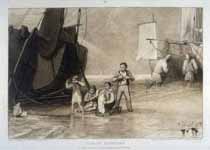

Martello Towers, near Bexhill, Sussex
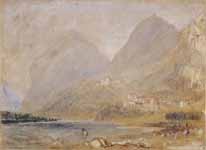

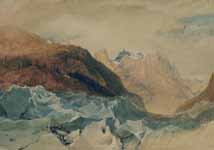
Mer de Glace, Chamonix, with Blair's Hut
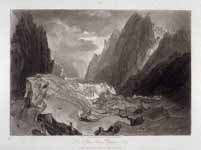
Mer de Glace, Valley of Chamouni, Savoy
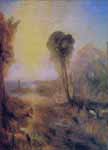
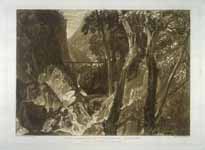
Mill near the Grand Chartreuse, Dauphiny
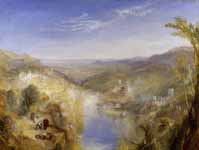
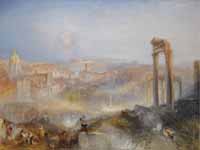
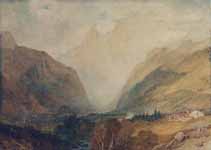
Mont Blanc, from above Courmayeur
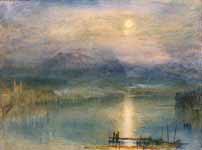
Moonlight on Lake Lucerne with the Rigi in the Distance, Switzerland

Morning amongst the Coniston Fells, Cumberland
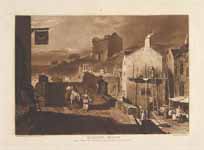
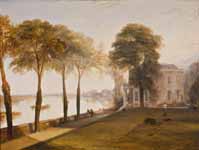
Mortlake Terrace, Early Summer Morning

Mortlake Terrace, the Seat of William Moffat, Summer's Evening
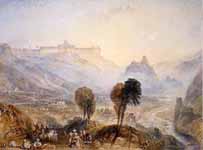
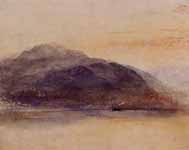
Mount Pilatus from across the Lake of Lucerne
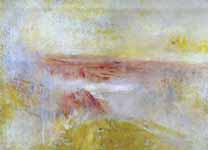
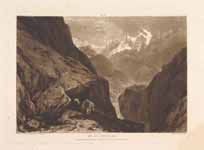
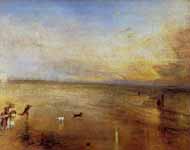
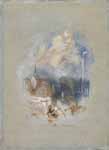
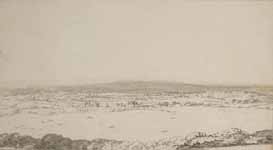
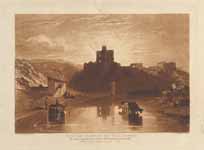
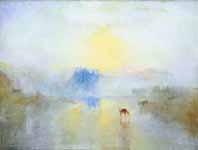

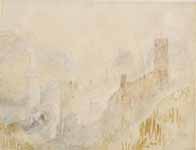
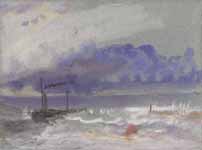
Off Yarmouth - A Steamship off the Coast in Rough Weather
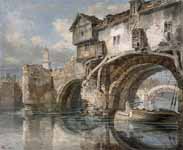
Old Welsh Bridge, Shrewsbury, Shropshire

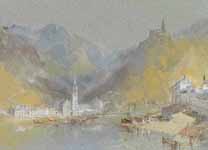
On the Mosel - Bernkastel, Kues and The Landshut, Germany
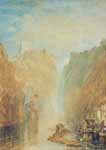

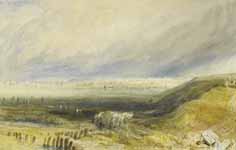
Oyster Beds at Whitstable, Kent

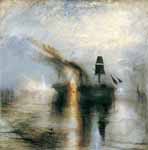

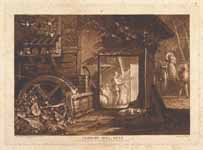
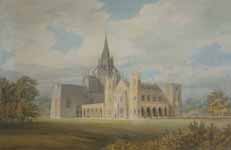
Perspective View of Fonthill Abbey from the South-West
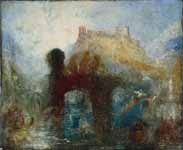
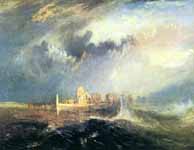
Quillebeuf, at the Mouth of Seine
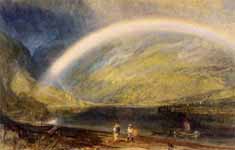
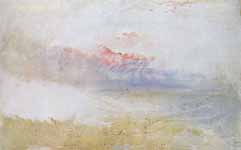

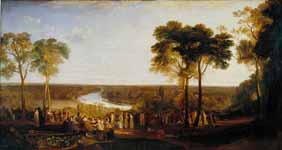
Richmond Hill, on the Prince Regent's Birthday
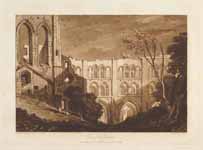
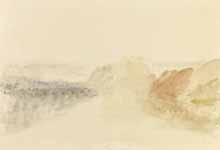
River Scene (Fort on a Rock above a River)
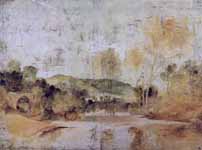
River Scene with Weir in the Middle Distance
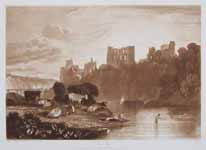


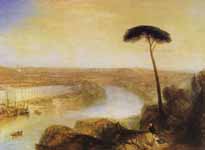
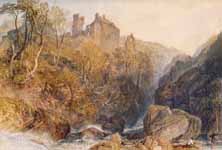
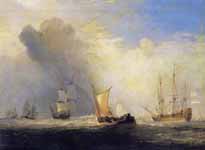

Saint Mary's Church, Nottingham
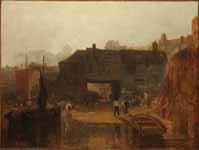
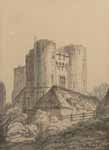
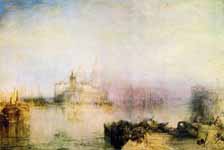
Santa Maria della Salute and Dogana

Scene on the French Coast,
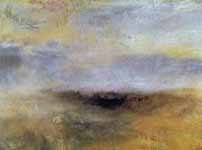
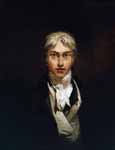

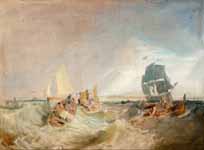
Shipping at the Mouth of the Thames
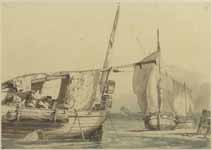
Shipping off the Coast, near Dover


Slave Ship (Slavers Throwing Overboard the Dead and Dying, Typhoon Coming On)
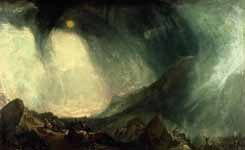
Snow Storm - Hannibal and his Army Crossing the Alps
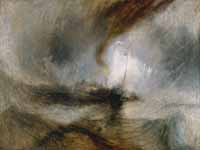
Snow Storm - Steam Boat off a Harbor's Mouth Making Signals in Shallow Water
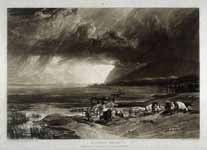

Source of the Arveron in the Valley of Chamouni, Savoy
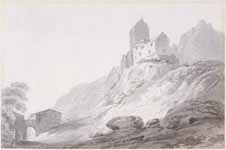
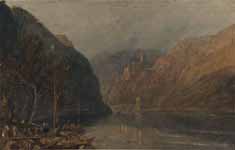
St Goarshausen and Katz Castle
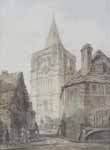
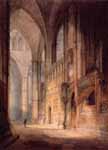
St. Erasmus in Bishop Islips Chapel, Westminster Abbey

Storm at the Mouth of the Grand Canal, Venice


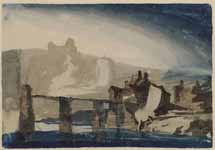
Fine Art Prints | Greeting Cards | Phone Cases | Lifestyle | Face Masks | Men's , Women' Apparel | Home Decor | jigsaw puzzles | Notebooks | Tapestries | ...
The Dogana and San Giorgio Maggiore
Joseph Mallord William "J. M. W." Turner, RA (baptised 14 May 1775[a] – 19 December 1851) was an English Romanticist landscape painter, water-colourist, and printmaker. Turner was considered a controversial figure in his day, but is now regarded as the artist who elevated landscape painting to an eminence rivalling history painting.[1] Although renowned for his oil paintings, Turner is also one of the greatest masters of British watercolour landscape painting. He is commonly known as "the painter of light"[2] and his work is regarded as a Romantic preface to Impressionism. Some of his works are cited as examples of abstract art prior to its recognition in the early 20th century.
Biography
Early life
Joseph Mallord William Turner was baptised on 14 May 1775, but his date of birth is unknown. It is generally believed he was born between late April and early May. Turner himself claimed he was born on 23 April, but there is no proof.[a] He was born in Maiden Lane, Covent Garden, in London, England.[3] His father, William Turner (1745–21 September 1829), was a barber and wig maker,[4] His mother, Mary Marshall, came from a family of butchers.[5] A younger sister, Mary Ann, was born in September 1778 but died in August 1783.[6]
Drawing of St John's Church, Margate by Turner from around 1786, when he would have been 11 or 12 years old. The ambitious but unsure drawing shows an early struggle with perspective, which can be contrasted with his later work
A View of the Archbishop's Palace, Lambeth – this watercolour was Turner's first to be accepted for the Royal Academy's annual exhibition in April 1790, the month he turned 15. The image is a technical presentation of Turner's strong grasp of the elements of perspective with several buildings at sharp angles to each other, demonstrating Turner's thorough mastery of Thomas Malton's topographical style.[7]
Fishermen at Sea exhibited in 1796 was the first oil painting exhibited by Turner at the Royal Academy
Modern Rome – Campo Vaccino
In 1785, due to his mother showing signs of the mental disturbance for which she was admitted first to St Luke's Hospital for Lunatics in Old Street in 1799 and then Bethlem Hospital in 1800,[8] the young Turner was sent to stay with his maternal uncle, Joseph Mallord William Marshall, in Brentford, then a small town on the banks of the River Thames west of London. From this period, the earliest known artistic exercise by Turner is found, a series of simple colourings of engraved plates from Henry Boswell's Picturesque View of the Antiquities of England and Wales.[9] Around 1786, Turner was sent to Margate on the north-east Kent coast. Here he produced a series of drawings of the town and surrounding area foreshadowing his later work. Turner returned to Margate many times in later life.[10] By this time, Turner's drawings were being exhibited in his father's shop window and sold for a few shillings.[5] His father boasted to the artist Thomas Stothard that: "My son, sir, is going to be a painter."[11] In 1789 Turner again stayed with his uncle, who had retired to Sunningwell in Berkshire (later, following the 1974 boundary changes, part of Oxfordshire). A whole sketchbook of work from this time in Berkshire survives, as well as a watercolour of Oxford. The use of pencil sketches on location as a basis for later finished paintings formed the basis of Turner's essential working style for his whole career.[9]
Many early sketches by Turner were architectural studies and/or exercises in perspective and it is known that as a young man he worked for several architects including Thomas Hardwick (junior), James Wyatt and Joseph Bonomi the Elder.[12] By the end of 1789 he had also begun to study under the topographical draughtsman Thomas Malton, whom Turner would later call "My real master."[13] He entered the Royal Academy of Art schools in 1789, when he was 14 years old,[14] and was accepted into the academy a year later. Sir Joshua Reynolds, president of the Royal Academy, chaired the panel that admitted him. At first Turner showed a keen interest in architecture but was advised to continue painting by the architect Thomas Hardwick. His first watercolour painting A View of the Archbishop's Palace, Lambeth was accepted for the Royal Academy summer exhibition of 1790 when Turner was 15.
As a probationer in the academy, he was taught drawing from plaster casts of antique sculptures and his name appears in the registry of the academy over a hundred times from July 1790 to October 1793.[15] In June 1792, he was admitted to the life class to learn to draw the human body from nude models.[16] Turner exhibited watercolours each year at the academy – travelling in the summer and painting in the winter. He travelled widely throughout Britain, particularly to Wales, and produced a wide range of sketches for working up into studies and watercolours. These particularly focused on architectural work, which utilised his skills as a draughtsman.[15] In 1793, he showed a watercolour titled The Rising Squall – Hot Wells from St Vincent's Rock Bristol (now lost) that foreshadowed his later climatic effects.[7] Cunningham in his obituary of Turner wrote that it was: "recognised by the wiser few as a noble attempt at lifting landscape art out of the tame insipidities...[and] evinced for the first time that mastery of effect for which he is now justly celebrated."[17]
Turner exhibited his first oil painting at the academy in 1796, Fishermen at Sea: a nocturnal moonlit scene of The Needles, which lie off the Isle of Wight. The image of boats in peril contrasts the cold light of the moon with the firelight glow of the fishermen's lantern.[18] Wilton said that the image: "Is a summary of all that had been said about the sea by the artists of the eighteenth century."[19] and shows strong influence by artists such as Horace Vernet, Philip James de Loutherbourg, Peter Monamy and Francis Swaine, who was admired for his moonlight marine paintings. This particular painting cannot be said to show any influence of Willem van de Velde the Younger, as not a single nocturnal scene is known by that painter. Some later work, however, as shown below, was created to rival or complement the manner of the Dutch artist. The image was praised by contemporary critics and founded Turner's reputation, both as an oil painter and as a painter of maritime scenes.[20]
Early career
Turner travelled widely in Europe, starting with France and Switzerland in 1802 and studying in the Louvre in Paris in the same year. He made many visits to Venice. On a visit to Lyme Regis, in Dorset, he painted a stormy scene (now in the Cincinnati Art Museum).
Important support for his work came from Walter Ramsden Fawkes, of Farnley Hall, near Otley in Yorkshire, who became a close friend of the artist. Turner first visited Otley in 1797, aged 22, when commissioned to paint watercolours of the area. He was so attracted to Otley and the surrounding area that he returned to it throughout his career. The stormy backdrop of Hannibal Crossing The Alps is reputed to have been inspired by a storm over the Chevin in Otley while he was staying at Farnley Hall.
Turner was a frequent guest of George O'Brien Wyndham, 3rd Earl of Egremont, at Petworth House in West Sussex and painted scenes that Egremont funded taken from the grounds of the house and of the Sussex countryside, including a view of the Chichester Canal. Petworth House still displays a number of paintings.
Personal life
As Turner grew older, he became more eccentric. He had few close friends except for his father, who lived with him for 30 years and worked as his studio assistant. His father's death in 1829 had a profound effect on him, and thereafter he was subject to bouts of depression. He never married but had a relationship with an older widow, Sarah Danby. He is believed to have been the father of her two daughters born in 1801 and 1811.[21]
Later he had a relationship with Sophia Caroline Booth, after her second husband died, living for about 18 years as 'Mr Booth' in her house in Chelsea.[22]
Like many of the day, Turner was a habitual user of snuff; in 1838 the King of France, Louis-Philippe, presented a gold snuff box to him.[23] Of two other snuffboxes, an agate and silver example bears Turner's name,[24] and another, made of wood, was collected along with his spectacles, magnifying glass and card case by an associate house keeper.[25]'
Death
Turner died in the house of his lover Sophia Caroline Booth in Cheyne Walk in Chelsea on 19 December 1851, and is said to have uttered the last words "The sun is God".[26] At his request he was buried in St Paul's Cathedral, where he lies next to Sir Joshua Reynolds. His last exhibition at the Royal Academy was in 1850.
Turner's friend, architect Philip Hardwick (1792–1870), son of his tutor, Thomas Hardwick, was in charge of making the funeral arrangements and wrote to those who knew Turner to tell them at the time of his death that, "I must inform you, we have lost him." Other executors were his cousin and chief mourner at the funeral, Henry Harpur IV (benefactor of Westminster – now Chelsea & Westminster – Hospital), Revd. Henry Scott Trimmer, George Jones RA and Charles Turner ARA.
Art
Style
One of Turner's most successful "house portraits": Raby Castle, the Seat of the Earl of Darlington[27] The Walters Art Museum.
Turner's talent was recognised early in his life. Financial independence allowed Turner to innovate freely; his mature work is characterised by a chromatic palette and broadly applied atmospheric washes of paint. According to David Piper's The Illustrated History of Art, his later pictures were called "fantastic puzzles." However, Turner was recognised as an artistic genius: the influential English art critic John Ruskin described him as the artist who could most "stirringly and truthfully measure the moods of Nature."[28]
Suitable vehicles for Turner's imagination were found in shipwrecks, fires (such as the burning of Parliament in 1834, an event which Turner rushed to witness first-hand, and which he transcribed in a series of watercolour sketches), natural catastrophes, and natural phenomena such as sunlight, storm, rain, and fog. He was fascinated by the violent power of the sea, as seen in Dawn after the Wreck (1840) and "The Slave Ship" (1840).
Snow Storm: Steam-Boat off a Harbour's Mouth, 1842
Turner's major venture into printmaking was the Liber Studiorum (Book of Studies), seventy prints that he worked on from 1806 to 1819. The Liber Studiorum was an expression of his intentions for landscape art. Loosely based on Claude Lorrain's Liber Veritatis (Book of Truth), the plates were meant to be widely disseminated, and categorised the genre into six types: Marine, Mountainous, Pastoral, Historical, Architectural, and Elevated or Epic Pastoral.[29] His printmaking was a major part of his output, and a museum is devoted to it, the Turner Museum in Sarasota, Florida, founded in 1974 by Douglass Montrose-Graem to house his collection of Turner prints.[30]
Turner placed human beings in many of his paintings to indicate his affection for humanity on the one hand (note the frequent scenes of people drinking and merry-making or working in the foreground), but its vulnerability and vulgarity amid the 'sublime' nature of the world on the other. 'Sublime' here means awe-inspiring, savage grandeur, a natural world unmastered by man, evidence of the power of God – a theme that romanticist artists and poets were exploring in this period. To Turner, light was the emanation of God's spirit and this was why he focused the subject matter of his later paintings by leaving out distractions such as solid objects and detail, concentrating on the play of light on water, the radiance of skies and fires. Although these late paintings appear to be 'impressionistic' and therefore a forerunner of the French school, Turner was striving for expression of spirituality in the world, rather than responding primarily to optical phenomena.
Rain, Steam and Speed – The Great Western Railway painted (1844).
His early works, such as Tintern Abbey (1795), stayed true to the traditions of English landscape. However, in Hannibal Crossing the Alps (1812), an emphasis on the destructive power of nature had already come into play. His distinctive style of painting, in which he used watercolour technique with oil paints, created lightness, fluency, and ephemeral atmospheric effects.[31]
In his later years he used oils ever more transparently, and turned to an evocation of almost pure light by use of shimmering colour. A prime example of his mature style can be seen in Rain, Steam and Speed - The Great Western Railway, where the objects are barely recognisable. The intensity of hue and interest in evanescent light not only placed Turner's work in the vanguard of English painting, but exerted an influence on art in France; the Impressionists, particularly Claude Monet, carefully studied his techniques.
Turner used pigments like carmine in his paintings, knowing that they were not long-lasting, despite the advice of contemporary experts to use more durable pigments. As a result, many of his colours have now faded greatly. John Ruskin complained at how quickly Turner's work decayed; Turner was indifferent to posterity and chose materials that looked good when freshly applied.[32] By 1930 there was concern that both his oils and his watercolours were fading.[33]
Chichester Canal's vivid colours may have been influenced by the eruption of Mount Tambora in 1815.
High levels of ash in the atmosphere during 1816, the "Year Without a Summer", led to unusually spectacular sunsets during this period, and were an inspiration for some of Turner's work.
John Ruskin says in his "Notes" on Turner in March 1878, that an early patron, Dr Thomas Monro, the Principal Physician of Bedlam, was a significant influence on Turner's style:
His true master was Dr Monro; to the practical teaching of that first patron and the wise simplicity of method of watercolour study, in which he was disciplined by him and companioned by Giston, the healthy and constant development of the greater power is primarily to be attributed; the greatness of the power itself, it is impossible to over-estimate.
On a trip to Europe, circa 1820, he met the Irish physician Robert James Graves. Graves was travelling in a diligence in the Alps when a man who looked like the mate of a ship got in, sat beside him, and soon took from his pocket a note-book across which his hand from time to time passed with the rapidity of lightning. Graves wondered if the man was insane, he looked, saw that the stranger had been noting the forms of clouds as they passed and that he was no common artist. The two travelled and sketched together for months. Graves tells that Turner would outline a scene, sit doing nothing for two or three days, then suddenly, "perhaps on the third day, he would exclaim 'there it is', and seizing his colours work rapidly till he had noted down the peculiar effect he wished to fix in his memory."
Wreckers Coast of Northumberland, painted ca. 1836. Yale Center for British Art
An engraving of a sketch by Turner depicting Brougham Castle. The sketch, made during a visit to the castle in 1809, provided the starting point for a later watercolour.
Turner's 1813 watercolour Ivy Bridge
The Fighting Temeraire tugged to her last berth to be broken up, 1839
The shipwreck of the Minotaur, oil on canvas
J.M.W. Turner, Calais Pier
The first American to buy a Turner painting was James Lenox of New York City, a private collector. Lenox wished to own a Turner and in 1845 bought one unseen through an intermediary, his friend C. R. Leslie. From among the paintings Turner had on hand and was willing to sell for £500, Leslie selected and shipped the 1832 atmospheric seascape Staffa, Fingal's Cave.[34] Worried about the painting's reception by Lenox, who knew Turner's work only through etchings, Leslie wrote to Lenox that the quality of Staffa, "a most poetic picture of a steam boat" would become apparent in time. On receiving the painting Lenox was baffled, and "greatly disappointed" by what he called the painting's "indistinctness". When Leslie was forced to relay this opinion to Turner, Turner said "You should tell Mr Lenox that indistinctness is my forte." Staffa, Fingal's Cave is now owned by the Yale Center for British Art.
Legacy
Turner left a small fortune which he hoped would be used to support what he called "decayed artists". He planned and designed an almshouse for them at Twickenham with a gallery for some of his works. His will was contested and in 1856, after a court battle, his first cousins, including Thomas Price Turner, received part of his fortune.[35] Another portion went to the Royal Academy of Arts, which occasionally awards students the Turner Medal. His collection of finished paintings was bequeathed to the British nation, and he intended that a special gallery would be built to house them. This did not happen because of a failure to agree on a site, and the parsimony of British governments. Twenty-two years after his death, the British Parliament passed an act allowing his paintings to be lent to museums outside London, and so began the process of scattering the pictures which Turner had wanted to be kept together. In 1910, the main part of the Turner Bequest, which includes unfinished paintings and drawings, was rehoused in the Duveen Turner Wing at the Tate Britain. In 1987, a new wing at the Tate, the Clore Gallery, was opened to house the Turner bequest, though some of the most important paintings remain in the National Gallery in contravention of Turner's condition that they be kept and shown together. Increasingly paintings are lent abroad, ignoring Turner's provision that they be kept "constantly" in Turner's Gallery. After the Turner content was diminished and diluted in the Clore Gallery from c. 2002, in 2010–12 only two of the nine rooms on the main floor were devoted to Turner. The claim that the Tate was fulfilling Turner's wishes was dropped in 1995, when the Charity Commission said that the Turner Bequest had been free of Turner's conditions. This was challenged by Leolin Price QC.
St. Mary's Church, Battersea added commemorative stained glass window to Turner, between 1976 and 1982.[36] St Paul's Cathedral, Royal Academy of Arts and Victoria & Albert Museum all hold statues representing him. A portrait drawing by Cornelius Varley with his patent graphic telescope (Sheffield Museums & Galleries) was compared with his death mask (National Portrait Gallery, London) by Kelly Freeman at Dundee University 2009–10 to ascertain whether it really depicts Turner. The city of Westminster unveiled a memorial plaque at the site of his birthplace at 21 Maiden Lane, Covent Garden 2 June 1999.[37]
Selby Wittingham founded The Turner Society at London and Manchester in 1975. After the society endorsed the Tate Gallery's Clore Gallery wing (on the lines of the Duveen wing of 1910), as the solution to the controversy of what should be done with the Turner Bequest, Selby Whittingham resigned and founded the Independent Turner Society.
The Tate created the prestigious annual Turner Prize art award in 1984, named in Turner's honour, and 20 years later the Royal Institute of Painters in Water Colours founded the Winsor & Newton Turner Watercolour Award.
A major exhibition, "Turner's Britain", with material (including The Fighting Temeraire) on loan from around the globe, was held at Birmingham Museum and Art Gallery from 7 November 2003 to 8 February 2004. In 2005, Turner's The Fighting Temeraire was voted Britain's "greatest painting" in a public poll organised by the BBC.[38]
Turner's Ovid Banished From Rome, 1838
In October 2005, Professor Harold V. Livermore (1914–2010), owner of Sandycombe Lodge for 60 years, gave the villa at Twickenham which Turner designed and built for himself, to the Sandycombe Lodge Trust to be preserved as a monument to the artist. In 2006, he also gave land to the Trust which had been part of Turner's domaine. The organisation The Friends of Turner's House was formed in 2004 to support it.
In April 2006, Christie's New York auctioned Giudecca, La Donna Della Salute and San Giorgio, a view of Venice exhibited at the Royal Academy in 1841, for US$35.8 million, setting a new record for a Turner work. The New York Times stated that according to two sources who requested anonymity the buyer was casino magnate Stephen Wynn.
In 2006, the Kimbell Art Museum returned Turner's Glaucus and Scylla (1840) to the heirs of John and Anna Jaffe after they made a holocaust claim.[39] The Kimbell repurchased the painting for $5.7 million at a sale by Christie's in April 2007.[40][41]
Between 1 October 2007 and 21 September 2008, the first major exhibition of Turner's work in the United States in more than 40 years came to the Metropolitan Museum of Art in New York, the National Gallery of Art in Washington, and the Dallas Museum of Art. It included over 140 paintings, more than half of which were from the Tate.
In 2011, Margate opened The Turner Contemporary gallery to celebrate the association of the artist with the town.[42]
The "Turner and his painters" exhibition (Tate Britain, London, 23 September 2009 to 31 January 2010, Paris, Grand Palais, 22 February to 24 May 2010) retraces and illustrates the development of Turner's personal vision, through the many chance or deliberate, but always opportune and enriching interactions that influenced his remarkable career. Nearly 100 paintings and other graphic works (studies and engravings) from major British and American collections, as well as the Louvre and the Prado were on show.[43]
On 7 July 2010, the J. Paul Getty Museum purchased Turner's final painting of Rome completed in 1839, Modern Rome – Campo Vaccino, at a Sotheby's auction in London for $44.9 million.
In 2015 the Getty Center museum in Los Angeles and De Young Museum in San Francisco are holding the exhibit "J. M. W. Turner: Painting Set Free" of over sixty key oil paintings and watercolors. It is the first major exhibition on the West Coast devoted to Turner's paintings, organized by Tate Britain in association with the J. Paul Getty Museum and the Fine Arts Museums of San Francisco. [44] [45]
Portrayal in theatre, television and film
Leo McKern played Turner in The Sun is God, a 1974 Thames Television production directed by Michael Darlow.[46] The program was shown on 17 December 1974, during the Turner Bicentenary Exhibition in London. [47] In January 2011 The Painter, a biographical play on his life by Rebecca Lenkiewicz, premiered at the Arcola Theatre in London. British filmmaker Mike Leigh wrote and directed Mr. Turner, a biopic of Turner's later years, released in 2014. The film starred Timothy Spall as Turner, Dorothy Atkinson, Marion Bailey, and Paul Jesson, and premiered in competition for the Palme d'Or at the 2014 Cannes Film Festival, with Spall taking the award for Best Actor.[48][49]
Selected works
Turner was an extremely prolific artist who produced more than 550 oil paintings, 2,000 watercolours, and 30,000 paper works.[50] The Tate Gallery in London produces the most comprehensive and up to date catalogue of Turner works[51] held in both public and private collections worldwide.
1796: Fishermen at Sea, oil on canvas, 36 × 48 1⁄8 in., Tate Gallery, London
1806: The Battle of Trafalgar, as Seen from the Mizen Starboard Shrouds of the Victory, oil on canvas: Tate Gallery, London
1809: The Trout Stream, oil on canvas, Taft Museum, Cincinnati
1812: Snow Storm: Hannibal and His Army Crossing the Alps, oil on canvas, Tate Gallery, London
1815: Dido Building Carthage, or, The Rise of the Carthaginian Empire, oil on canvas, National Gallery, London
1815: Crossing the Brook, oil on canvas, Tate Gallery, London
1817: Eruption of Vesuvius, watercolour, gum, and scraping out on paper, Yale Center for British Art, New Haven, Connecticut
1817: Raby Castle, the Seat of the Earl of Darlington, oil on canvas, Walters Art Museum, Baltimore
1822: The Battle of Trafalgar, oil on canvas, National Maritime Museum, Greenwich, London
1826: Cologne: The Arrival of a Packet-Boat: Evening, oil and possibly watercolor on canvas (lined), Frick Collection, New York
1829: Ulysses Deriding Polyphemus, oil on canvas, National Gallery, London
1834: Venice: The Dogana and San Giorgio Maggiore, oil on canvas, National Gallery of Art, Washington, DC
1834: The Fountain of Indolence, oil on canvas, Beaverbrook Art Gallery, Fredericton
1835: The Burning of the Houses of Lords and Commons, oil on canvas, Philadelphia Museum of Art, Philadelphia
1835: The Burning of the Houses of Lords and Commons, oil on canvas, Cleveland Museum of Art, Cleveland
1835: The Grand Canal, Venice, oil on canvas, Metropolitan Museum of Art, New York
1835: The Piazzetta, Venice, Watercolour and bodycolour with pen and ink and scraping on paper, Scottish National Gallery, Edinburgh
1836: Juliet and Her Nurse. Oil on canvas. Exh. Royal Academy. 36 1⁄2 × 48 1⁄2 (92 × 123).
1838: The Fighting Temeraire Tugged to Her Last Berth to Be Broken up, oil on canvas, National Gallery, London
1840: Slave Ship (Slavers Throwing Overboard the Dead and Dying, Typhoon Coming On), oil on canvas, Museum of Fine Arts, Boston
1842: The Blue Rigi, Sunrise, watercolour on paper, Tate Britain, London
1842: Snow Storm: Steam-Boat off a Harbour's Mouth
1843: The Evening of the Deluge, oil on canvas, Tate Gallery, London
1844: Ostende, oil on canvas, Neue Pinakothek, München
1844: Approach to Venice, oil on canvas, National Gallery of Art, Washington, DC
1844: Rain, Steam and Speed - The Great Western Railway, oil on canvas, National Gallery, London
c. 1845: Sunrise with Sea Monsters, oil on canvas, Tate Gallery, London
c. 1840–1850: Europa and the Bull, oil on canvas, Taft Museum, Cincinnati
See also
Art of the United Kingdom
Cloudscape (art)
History of painting
List of British painters
Theory of Colours
Western painting
Notes
a. ^ Turner is believed to have been born some time between late April and early May 1775; his exact date of birth is unknown. The date of 23 April, which is both Saint George's Day and the supposed birthday of William Shakespeare, was the date Turner himself claimed to have been born, but this claim has never been verified.[3] The first verifiable date is that Turner was baptised on 14 May. This casts some doubt on 23 April date, as high infant mortality rates meant parents would usually baptise their children shortly after birth.[52]
b.^ Mary Marshall died in 1804, after having been committed in 1799 to St Luke's Hospital and then to the Bethlem Royal Hospital, a mental asylum. Her illness possibly due in part to the early death of Turner's younger sister. Hamilton suggests that this "fit of illness" may have been an early sign of her madness.
References
Lacayo, Richard (11 October 2007). "The Sunshine Boy". Time. "At the turn of the 18th century, history painting was the highest purpose art could serve, and Turner would attempt those heights all his life. But his real achievement would be to make landscape the equal of history painting."
"Joseph Mallord William Turner". National Gallery. Retrieved 2014-09-03.
Shanes, Eric (2008). The life and masterworks of J.M.W. Turner (4th ed.). New York: Parkstone Press. ISBN 978-1-85995-681-6.
Herrmann, Luke (October 2006). Joseph Mallord William Turner. Oxford Dictionary of National Biography (Oxford University Press).
Hamilton, James (2007). Turner. New York: Random House. Chapter 1. ISBN 978-0-8129-6791-3. (subscription required (help)).
Bailey, Anthony (1998). Standing in the sun: a life of J.M.W. Turner. London: Pimlico. p. 8. ISBN 0-7126-6604-4. (subscription required (help)).
Wilton, Andrew (2006). Turner in his time (New ed.). London: Thames & Hudson. p. 20. ISBN 978-0-500-23830-1.
Brown, David. "J.M.W. Turner: Sketchbooks, Drawings and Watercolours". tate.org.uk/art/research-publications/jmw-turner/joseph-mallord-william-turner-1775-1851-r1141041 Blayney Brown (ed.),. Retrieved 11 December 2014.
Wilton, Andrew (2006). Turner in his time (New ed.). London: Thames & Hudson. p. 14. ISBN 978-0-500-23830-1.
Wilton, Andrew (2006). Turner in his time (New ed.). London: Thames & Hudson. p. 15. ISBN 978-0-500-23830-1.
Thornbury, George Walter (1862). The life of J.M.W. Turner. p. 8.
Hamilton, James (1997). "1". Turner : a life. London: Sceptre. ISBN 0-340-62811-1.
Thornbury, George Walter (1862). The life of J.M.W. Turner. p. 27.
Finberg, A. J. (1961). The Life of J.M.W. Turner, R.A. Clarendon Press. p. 17.
Hamilton, James (2007). Turner. New York: Random House. Chapter 2. ISBN 978-0-8129-6791-3.
Wilton, Andrew (2006). Turner in his time (New ed.). London: Thames & Hudson. p. 17. ISBN 978-0-500-23830-1.
Cunningham, Peter (27 December 1851). "Obituary of Turner". The Athenaeum. pp. 17–18.
Butlin, Martin; Joll, Evelyn (1984). The paintings of J.M.W. Turner (Rev. ed.). New Haven: Yale University Press. ISBN 978-0-300-03276-5.
Wilton, Andrew (2006). Turner in his time (New ed. ed.). London: Thames & Hudson. p. 27. ISBN 978-0-500-23830-1.
Wilton, Andrew (2006). Turner in his time (New ed.). London: Thames & Hudson. p. 28. ISBN 978-0-500-23830-1.
Roberts, Miquette. "The Unknown Turner". Tate. Retrieved 14 July 2014.
http://www.turnersociety.org.uk/Turner_biography.pdf
"Collection Online: Snuff Box/box". British Museum.
"Georgian Silver and Agate Pocket Snuff Box Inscribed 'Joseph Mallord William Turner' and the date '1785'". Finch & Co. Retrieved 2014-09-03.
"Spectacles, glass, snuffbox and cardcase of Turner 1775 – 1851". Philip Mould & Company. Retrieved 2014-09-03.
Davies, Norman (20 January 1998). Europe: A History. London: Pimlico. p. 687. ISBN 978-0060974688. Retrieved 2014-09-03. (subscription required (help)).
"Raby Castle, the Seat of the Earl of Darlington". Walters Art Museum.
(Piper 321)
Imms, Matthew (December 2012). Brown, David Blayney, ed. "J.M.W. Turner: Sketchbooks, Drawings and Watercolours". Tate Gallery. Retrieved 2014-09-03.
"The Turner Museum". The Turner Museum and Thomas Moran Galleries. Retrieved 30 August 2010.
Piper 321
Finlay, Victoria (2004). Color: A Natural History of the Palette. Random House Trade Paperbacks. pp. 134–135. ISBN 0812971426. (subscription required (help)).
"Colors That Fade: Turner's Masterpieces: Can his works be saved?". The Daily News. 9 January 1930. p. 2. Retrieved 18 May 2014.
"The Art Archive, J.M.W. Turner, Staffa, Fingal's cave". Artchive.com. Retrieved 2 May 2012.
Monkhouse, William Cosmo (1879). The Great Artists: J.M.W. Turner R.A. New York: Scribner and Welford. p. 121. Retrieved 2014-09-03.
"St. Mary's Church Parish website". "St Mary's Modern Stained Glass"
"Joseph Mallord William Turner". City of Westminster. Retrieved 2014-09-03.
"Turner wins 'great painting' vote". BBC News. 5 September 2005. Retrieved 2014-09-03.
"Kimbell Art Museum Returns Turner Painting To Heirs". Artdaily.com. Retrieved 2014-09-03.
"Christie's New York important old master paintings sale totals $57.5 million". News-antique.com. 19 April 2007. Retrieved 2014-09-03.
"Fort Worth museum plans to return looted painting". Fort Worth Star-Telegram (lootedart.com). 6 June 2006. Retrieved 2014-09-03.
"About Us". Turner Contemporary. Retrieved 2014-09-03.
"Turner – Grand Palais" (in French). Artistik Rezo. 2 March 2010. Retrieved 2014-09-03.
Getty Museum: J. M. W. Turner: Painting Set Free exhibit; February 24—May 24, 2015; accessed 2.22.2015
De Young Museum: J. M. W. Turner: Painting Set Free exhibit; June 20—September 20, 2015; accessed 2.22.2015
"The Sun Is God (1974)". British Film Institute. Retrieved 31 March 2015.
Whaley, George (2009). Leo 'Rumpole' McKern: The Accidental Actor. UNSW Press. p. 181. ISBN 9781921410895. Retrieved 31 March 2015.
Child, Ben (23 October 2012). "Timothy Spall to play JMW Turner in Mike Leigh biopic". The Guardian. Retrieved 2014-09-03.
"Mr. Turner". Film 4. Retrieved 2014-09-03.
"Turner Society Homepage". Retrieved 27 November 2011.
"Joseph Mallord William Turner". Tate. Retrieved 2014-09-03.
Hamilton, James (2007). Turner (Random House Trade Paperback ed. ed.). New York: Random House. p. 8. ISBN 978-0-8129-6791-3.
Sources
Bailey, Anthony (1998). Standing in the sun: A Life of J. M. W. Turner. London: Pimlico. ISBN 0-7126-6604-4.
Bockemühl, Michael (2006). J. M. W. Turner, 1775–1851: the world of light and colour (2nd ed.). Köln: Taschen. ISBN 3-8228-6325-4.
Finberg, A. J. The Life of J. M. W. Turner, R.A. (Oxford: Oxford University Press, 1939 and 1961)
Hamilton, James (2007). Turner. New York: Random House. ISBN 978-0-8129-6791-3.
Harrison, Colin. Turner's Oxford (Ashmolean Museum, Oxford, 2000)
Hill, David. Turner and Leeds: Image of Industry (Jeremy Mills Publishing, 2008)
Warburton, Stanley. Discovering Turner's Lakeland (Lytham St Annes, 2008)
Whittingham, Selby. An Historical Account of the Will of J. M. W. Turner, R.A. (J. M. W. Turner, R.A., Publications, London, 1993-6)
Wilton, Andrew (2006). Turner in His Time (Revised ed.). London: Thames & Hudson. ISBN 978-0-500-23830-1.
Further reading
Joll, Evelyn (ed.); Butlin, Martin, Herrmann, Luke (2001). The Oxford companion to J. M. W. Turner. Oxford: Oxford Univ. Press. ISBN 0-19-860025-9.
Barker, Elizabeth E. "Joseph Mallord William Turner (1775–1851)". Heilbrunn Timeline of Art History. The Metropolitan Museum of Art.
Ackroyd, Peter (2005). J. M. W. Turner. Ackroyd's Brief Lives (1st ed.). New York: Nan A. Talese. ISBN 0-385-50798-4.
Venning, Barry (2003). Turner (1st publ. ed.). Berlin: Phaidon Verlag GmbH. ISBN 0-7148-3988-4.
Artist
A - B - C - D - E - F - G - H - I - J - K - L - M -
N - O - P - Q - R - S - T - U - V - W - X - Y - Z
Retrieved from "http://en.wikipedia.org/"
All text is available under the terms of the GNU Free Documentation License




